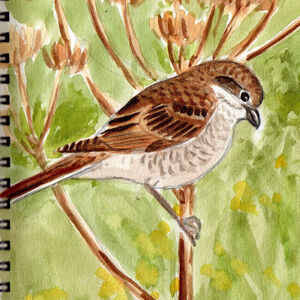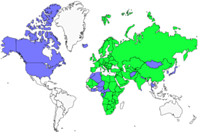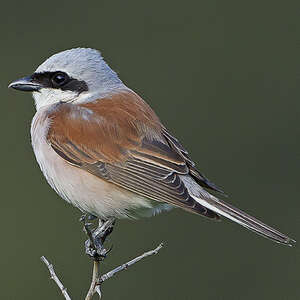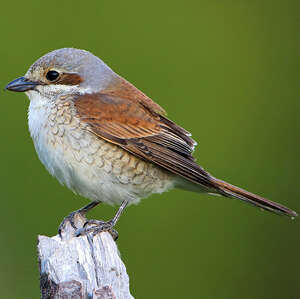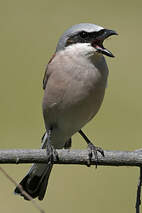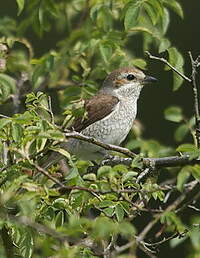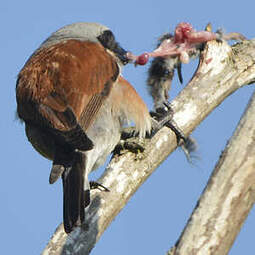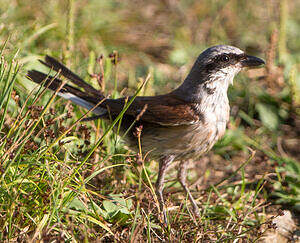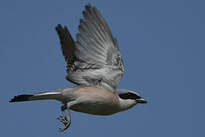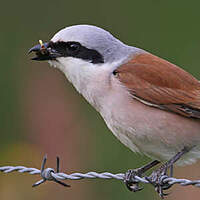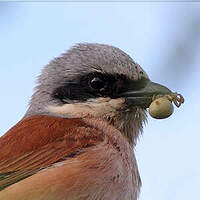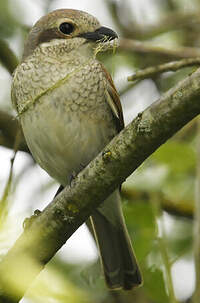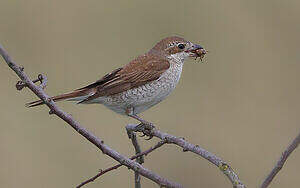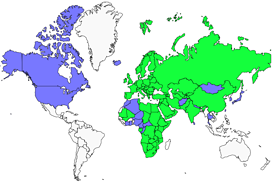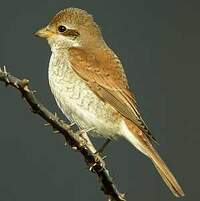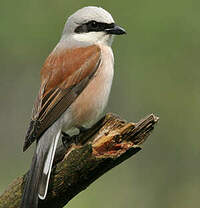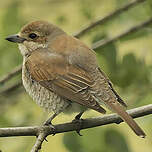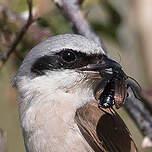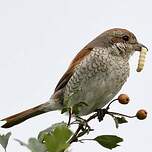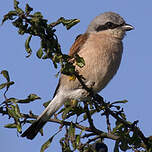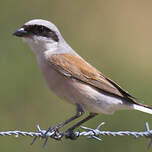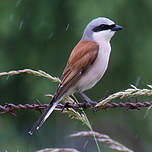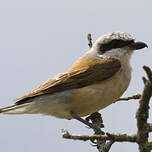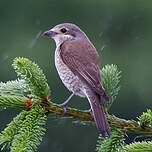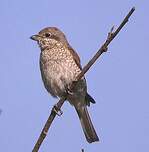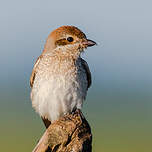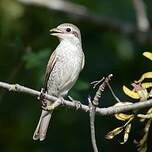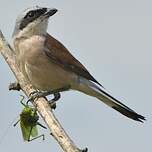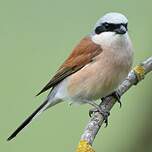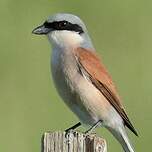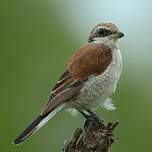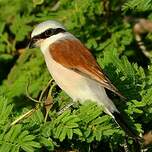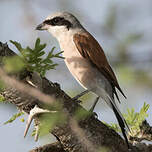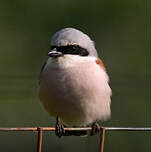Red-backed Shrike
Lanius collurio - Pie-grièche écorcheur
Identification
The Red-backed Shrike is one of our most beautiful passerines. Its size is clearly larger than that of a sparrow. Like all members of the Laniid family, it has a strong and hooked beak. The adult male can easily be recognized. His mantle is a bright light brown. The underside is clearly salmon colored, which is particularly evident on the sides. Its light gray head is barred laterally with a very contrasting black mask covering the ears, including the dark eye and reaching the forehead. Often a clear line slips between the band and the cap, forming a eyebrow. The tail is black and white in a clearly visible design in flight. The bottom of the back and the rump are the same gray as the head. The throat and undertail are white. The beak and feet are black. The adult female is similar in silhouette and proportions to the male, but the colors are different. These are less sharp and the contrasts are less. The mantle, wings and tail are a rather dull reddish brown. The head, lower back and rump are reddish brown light with a clearly visible gray hue, clearly visible at the nape. The headband is the same color as the mantle and is limited to the back of the eye. The whitish eyebrow, often evident, joins the forehead and pale lores. The underside is whitish with clear brown vermiculations on the chest and sides giving an scaly appearance. The white of the tail is limited to a narrow lateral border. The beak is brown with a pinkish base. The legs are brownish. The juvenile looks like the female, but its plumage is more marked. It often presents a clear reddish hue that can lead to confusion with the Great Grey Shrike or Turkestan Shrike. The head looks mottled. The mantle looks scaly. The wing covers and tertiaries show a large bicolor edging, dark brown and cream rusty.The underside is light beige with distinct mottling or dark brown bars. The beak is horn-colored. The immature keeps some of its juvenile characteristics at the beginning of its second year, and a one-year-old female can still be differentiated by the plumage of a two-year-old or older female.
Subspecific information monotypic species
Foreign names
- Pie-grièche écorcheur,
- Alcaudón dorsirrojo,
- picanço-de-dorso-ruivo,
- Neuntöter,
- tövisszúró gébics,
- Grauwe Klauwier,
- Averla piccola,
- törnskata,
- Tornskate,
- strakoš obyčajný,
- ťuhýk obecný,
- Rødrygget Tornskade,
- pikkulepinkäinen,
- Rooiruglaksman,
- escorxador comú,
- Þyrnisvarri,
- gąsiorek,
- brūnā čakste,
- rjavi srakoper,
- Жулан,
- セアカモズ,
- 红背伯劳,
- 紅背伯勞,
Voice song and cries
The male's song is a pleasant but quiet potpourri, which includes imitations of other birds and thus resembling a warbler or Icterine Warbler's song. The male's territorial call is a strong, repeated tjein uttered from a exposed perch. In case of danger, male and female both utter sharp, loud teks of distress. In extreme danger, a series of tchien tchien tchien tchien... resembles the cry of a falcon.
Habitat
The breeding habitat of the Red-backed Shrike always has two essential characteristics. It must have dense shrubs or bushes that are suitable for nesting (such as blackthorn, hawthorn, and dog-rose, or young conifers).
Behaviour character trait
The Red-backed Shrike is an easy bird to detect in the wild as, despite its quite timid nature, it is not shy to show itself in a noticeable perch (like the top of a bush, a fence post, or aerial wire).
Alerted, it will flap its long tail and cry out in distress. If it feels truly threatened, it will quickly dart off and hide in the bushes. During breeding season it is a territorial species, nesting in pairs. The male is very aggressive to its peers, especially when establishing territory. It searches for the highest perches to make its presence known and scares away any potential rivals with loud warning cries. Despite its territoriality, its population density can be quite high in favorable habitats. It can reach one pair per 100m of hedgerow in grassland or one pair per hectare in the herbaceous environment with bushes. The courtship dance is a sight to behold, but you have to be there at the right time as it is quite short. The male, proud of its beautiful colours, displays himself in front of the female, chest raised in a vertical position, displaying its lovely pink colouring and its two-toned tail. The species can become quite evident again in its environment when breeding ends, when young ones are crying out for food. It is a great migrant, only spending four to five months in its nesting area. It returns under our latitudes in May and leaves once the young are independent, from August to September.Flight
The flight of a Red-backed Shrike is direct and assured. Its long migratory wings allow it to do so. On its breeding grounds, most of the activity is focused on the ground and the lower levels, and as a result, the flight is itself low in altitude. Its nocturnal migration movements escape observation. In some hunting situations it is able to remain hovering to scan for prey in grassland areas. It can also chase after flying prey on occasion.
Dietfeeding habits
The Red-backed Shrike's diet consists mainly of large insects, particularly Coleoptera, Orthoptera, and Lepidoptera, but also of small vertebrates (young fieldmice, small lizards, emerging Amphibians, etc.
It usually hunts from an exposed perch, and captures its prey on the ground. It also frequently pursues large insects (Hymenoptera, Odonata) in flight. On abundant days, when prey is plentiful, it is known to store food for leaner times. To do this, it impales unused prey on a thorny twig or barbed wire for rainy days when food is scarce.Reproduction nesting
The male chooses the nesting site which he will construct with his partner in 4 to 6 days. In the majority of cases, the nest is situated at a height of 1 to 1.
meters in a spiny bush or small conifer. It is a rather massive construction, 15 cm in diameter on average with a height of 8 cm, made of materials as diverse (stems and twigs, herbs, moss, ..) and heterogeneous (pieces of string, small pieces of paper, ..). The cup is filled with finer and softer elements (rootlets, sheep's wool, mane). The female lays 4 to 6 eggs, grey-green or brownish in colour with brown spots in a crown towards the large end. She takes care of the incubation which lasting from 14 to 16 days, then the parents feed the young ones in the nest for an equivalent period of time. After that, after their departure from the nest, the family splits into two, each adult taking charge of half of the nest for 3 more weeks. Quite quickly after the emancipation of the young, the post-nuptial migration towards Africa will begin. The Red-backed Shrike only has time to raise one brood per year.Geographic range
The Red-backed Shrike is a species mainly found in Europe. Its breeding range extends to the temperate lattiudes of the Atlantic coasts (Loire and Spanish Finisterre) to the heart of Russia where it reaches and even surpasses the Valley of the Ob. It is absent from the British Isles and the French coast of the Channel whose oceanic climate does not suit it. In the north, it reaches the Gulf of Bothnia and the western Siberia. In the south, it occupies some islands of the Mediterranean, Turkey, and from there reaches the Northwest of Iran through the south of the Caspian Sea. It is very local in the Middle East. It is a great migratory species whose wintering range is located in the south and southeast of Africa, starting from Kenya and Uganda. The migration routes are eastern and pass through the east of the Mediterranean and the Middle East. The remoteness of the wintering grounds explains the late arrival of the nesters, from May, in their breeding territories.
Threats - protection
IUCN conservation status
concern
in the Wild
threatened
evaluated
The Red-backed Shrike is not yet experiencing the pronounced decline that all of the other European shrike species are. It is still quite common. Nevertheless, a regression is often mentioned in Western Europe while it does not seem to be the case in the East of its range. It is certain that modifications or the disappearance of its habitat due to the modernization of agriculture and the regression of large insect prey, caused by the excessive use of insecticides in developed or developing countries, can only have a negative impact. Locally, large-scale reforestation is another negative factor.
Sources of information
- IOC World Bird List (v14.1), Gill, F and D Donsker (Eds). 2024-04-18.
- SHRIKES A Guide to the Shrikes of the World, Lefranc Norbert, Worfolk Tim
- Avibase, Lepage Denis
- HBW Alive,
- xeno-canto, Sharing bird sounds from around the world,
Other sources of interest
 Specification sheet created on
18/07/2023 by Jean François
Specification sheet created on
18/07/2023 by Jean FrançoisTranslation by AI Oiseaux.net
published: 16-01-2017 - Updated: 15-04-2017
© 1996-2024 Oiseaux.net
- Accipitriformes
- Aegotheliformes
- Anseriformes
- Apodiformes
- Apterygiformes
- Bucerotiformes
- Caprimulgiformes
- Cariamiformes
- Casuariiformes
- Charadriiformes
- Ciconiiformes
- Coliiformes
- Columbiformes
- Coraciiformes
- Cuculiformes
- Eurypygiformes
- Falconiformes
- Galliformes
- Gaviiformes
- Gruiformes
- Leptosomiformes
- Mesitornithiformes
- Musophagiformes
- Nyctibiiformes
- Opisthocomiformes
- Otidiformes
- Passeriformes
- Pelecaniformes
- Phaethontiformes
- Phoenicopteriformes
- Piciformes
- Podargiformes
- Podicipediformes
- Procellariiformes
- Psittaciformes
- Pterocliformes
- Rheiformes
- Sphenisciformes
- Steatornithiformes
- Strigiformes
- Struthioniformes
- Suliformes
- Tinamiformes
- Trogoniformes

